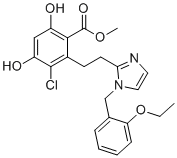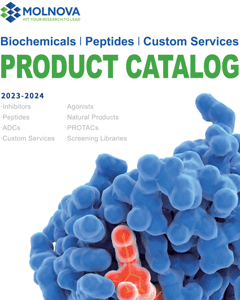
KUNG29
CAS No. 1887032-92-9
KUNG29( KUNG-29 | KUNG 29 )
Catalog No. M12952 CAS No. 1887032-92-9
A potent, selective Grp94 inhibitor with Kd of 0.2 uM.
Purity : >98% (HPLC)
 COA
COA
 Datasheet
Datasheet
 HNMR
HNMR
 HPLC
HPLC
 MSDS
MSDS
 Handing Instructions
Handing Instructions
| Size | Price / USD | Stock | Quantity |
| 5MG | 963 | Get Quote |


|
| 50MG | 1962 | Get Quote |


|
| 100MG | 2520 | Get Quote |


|
| 200MG | Get Quote | Get Quote |


|
| 500MG | Get Quote | Get Quote |


|
| 1G | Get Quote | Get Quote |


|
Biological Information
-
Product NameKUNG29
-
NoteResearch use only, not for human use.
-
Brief DescriptionA potent, selective Grp94 inhibitor with Kd of 0.2 uM.
-
DescriptionA potent, selective Grp94 inhibitor with Kd of 0.2 uM; displays 40-fold selecticity over Hsp90α; induces the degradation of integrin α2 in MDA-MB-231 cells.
-
In Vitro——
-
In Vivo——
-
SynonymsKUNG-29 | KUNG 29
-
PathwayCytoskeleton/Cell Adhesion Molecules
-
TargetHSP
-
RecptorHSP
-
Research Area——
-
Indication——
Chemical Information
-
CAS Number1887032-92-9
-
Formula Weight430.89
-
Molecular FormulaC22H23ClN2O5
-
Purity>98% (HPLC)
-
Solubility——
-
SMILESO=C(OC)C1=C(O)C=C(O)C(Cl)=C1CCC2=NC=CN2CC3=CC=CC=C3OCC
-
Chemical NameMethyl 3-Chloro-2-(2-(1-(2-ethoxybenzyl)-1H-imidazol-2-yl)-ethyl)-4,6-dihydroxybenzoate
Shipping & Storage Information
-
Storage(-20℃)
-
ShippingWith Ice Pack
-
Stability≥ 2 years
Reference
1. Crowley VM, et al. J Med Chem. 2016 Apr 14;59(7):3471-88.
molnova catalog



related products
-
NVP-BEP800
A potent and selective Hsp90β inhibitor with IC50 of 58 nM; shows >70-fold selective against Grp94 and Trap-1.
-
HS-27
HS-27 is a fluorescently-tethered inhibitor of Hsp90 with SNX-5422 tethered via a PEG linker to a fluorescein isothiocyanate or FITC. HS-27 can be used in see-and-treat paradigms.
-
KRIBB11
KRIBB11 is a small molecule heat shock factor 1 (HSF1) inhibitor with IC50 of 1.2 uM.



 Cart
Cart
 sales@molnova.com
sales@molnova.com


